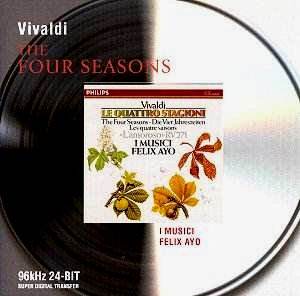 |
Antonio VIVALDI (1678-1741)
Crotchet AmazonUK AmazonUS Amazon recommendations |
Ranking amongst the most popular pieces of music ever written, The Four Seasons has elicited a multitude of responses over the years: from Kennedy's (in)famous set (with the English Chamber Orchestra, EMI CDC5 56253-2), Mutter (with the Trondheim Soloists, DG 463 259-2) and Kremer's ingenious coupling of Vivaldi and Piazzolla ('Eight Seasons', 7559-79568-2) to the authenticist Onofri (Il Giardino Armonico, Teldec 0630-14619-2) and the dramatic Carmignola (Venice Baroque Orchestra/Andrea Marconi on Sony Classical SK51352). If ever there was an example of a text acting as a generator for a multiplicity of interpretations, this is it. Felix Ayo's account with I Musici seems to have been eternally lurking around the shops in some incarnation or other, and here it is again in its latest reissue.
Philips has nominated it as one of its '50 Great Recordings'. The justification for this inclusion seems to be rather difficult to fathom, unless it is for purely sentimental reasons. Ayo's tempos are generally a little low on juice. The very first movement of The Seasons sets the tone, distinctly lacking in vital energy. In the second movement of 'Spring', Ayo floats beautifully over an accompaniment that is simply too heavy, and the third movement brings Karajan's stodge-fest approach to baroque music to mind.
There are some spirited exchanges in the Adagio molto movement of 'Autumn', which inspires some hope: hopes only dashed by the three-quarter speed hunt-finale. Some sense of repose is achieved in the second movement, although it is distinctly un-Vivaldian. The Largo of 'Winter' perhaps comes off best. Ayo phrases lyrically without over-egging the pudding, although even here the bed of pizzicato that acts as accompaniment is too resonant.
The concerto nicknamed 'L'amoroso' unfortunately, but inevitably, receives the same treatment, the 'cantabile' direction for the slow movement being taken as a cue for some unwarranted Romanticism.
Listening to this disc is like looking through a window in time to an age before informed period practice. For some, it will be nostalgic. But for the majority, it will frequently just sound misguided. I would certainly hope that nobody has the misfortune to be introduced for the first time to these evergreen concertos in this way.
Colin Clarke